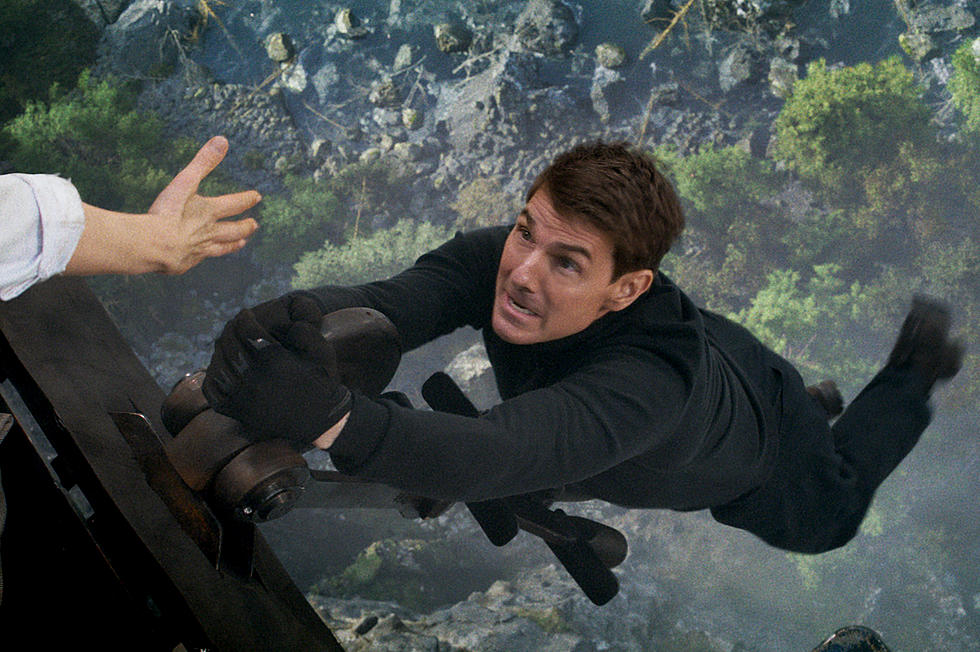
‘Mission: Impossible – Dead Reckoning’ Review
When last we saw Tom Cruise in Top Gun: Maverick, he was flying around in real planes thousands of feet in the air as part of that film’s incredible dogfight sequences. How could you possibly top that?
You fly without a plane, of course.
That brings us to Mission: Impossible - Dead Reckoning Part One, where Cruise drives a motorcycle off a mountain and then parachutes into the gorge below. The camera zooms behind Cruise as he drives right off the edge of this enormous precipice and then cranes down to watch him fall. Then the camera seems to be sailing through the air right next to Cruise — at one point, there is a back-and-forth dialogue exchange between him and another actor while Cruise is still actively falling through the air.
So, yes, Mission: Impossible - Dead Reckoning Part One gives you your money’s worth in the gonzo visuals department. And while it is the seventh film in the Mission: Impossible series, it also feels like a spiritual sequel to Top Gun: Maverick, and a continuation of its themes about old school filmmaking versus new school CGI.
In Maverick, Cruise’s test pilot supreme Pete “Maverick” Mitchell learns the Navy wants to put him out to pasture because advances in unmanned drone technology has rendered him obsolete. Maverick gets sent back to Top Gun pilot academy, then proves his continuing worth by leading a suicide mission without a single casualty. Top Gun: Maverick’s amazing practical aerial photography, flashy as it was, also worked to underscore that idea by foregrounding the value of classic stunt work in a digital age.
READ MORE: All the Most Dated Technology From the First Mission: Impossible
That whole concept continues in Dead Reckoning, where the conceit of Tom Cruise versus an all-powerful computerized enemy gets a promotion from subtextual threat to central villain of the narrative. Cruise, as secret agent supreme Ethan Hunt (who, it must be said, is also a bit of a maverick), learns of the existence of “The Entity,” a self-aware artificial intelligence capable of infecting every corner of the internet and manipulating digital reality to suit its own agenda.
With the Entity right on the cusp of going full Skynet, the key to stopping it is, well, a key — an elaborate, two-piece cruciform doohickey that, when combined into a single object, will do ... something. No one in Dead Reckoning — not even Ethan’s superiors in the U.S. intelligence community (including Henry Czerny’s Eugene Kittridge from the very first Mission: Impossible) — is sure what the key unlocks. But supposedly every country on Earth hopes the key will allow them to control the Entity, and with it, become the dominant superpower on the planet.
So Kittridge sends Ethan Hunt and his Impossible Mission Force to locate and return the key. But Ethan Hunt has his own ideas about right and wrong, and he’s never met an order he couldn’t disobey if it meant staying true to his own principles. Ethan decides the Entity cannot be allowed to exist, even under the auspices of the U.S. Government. So he must find the key, and then use it to destroy the Entity.
That’s Ethan Hunt in a nutshell: He’s loyal to people rather than organizations, he’s not afraid to break the law (or a few rules) to serve the greater good, and he refuses to believe that any mission is truly impossible. That ethos — along with a track record of outstanding setpieces – has kept the Mission: Impossible series churning out dependable entertainments for almost 30 years.
Dead Reckoning is no exception. It’s got a terrific cast and big action scenes, and even though it is yet another Part One sequel in a string of them this summer (we’ve already had Across the Spider-Verse and Fast X) it’s probably the one that feels the most like a complete experience unto itself, simply because so much bonkers s— happens in 163 minutes that you don’t leave the theater feeling like you’ve only watched half a movie.
While the Mission: Impossibles before the arrival of writer/director Christopher McQuarrie varied in tone and style, the four since have remained quite consistent: Over-the-top stunts and thrills, crackling dialogue, and an increasing emphasis on the bonds of friendship between Ethan and his team, including computer whizzes Luther Stickell (Ving Rhames) and Benji Dunn (Simon Pegg), and disavowed MI6 spy Ilsa Faust (Rebecca Ferguson), who shares Ethan’s distaste for blind nationalistic fealty. This, too, turns out to be another facet of McQuarrie and Cruise’s thriller-as-metaphor-for-filmmaking metaphor; the most important value in Dead Reckoning is not patriotism. It’s collaboration.
Ethan Hunt’s newest collaborator in Dead Reckoning is a mysterious woman named Grace (Hayley Atwell) who winds up with half of the cruciform key and then repeatedly crosses paths with the IMF as they all race from Rome to Venice to the Alps to get their hands on the other. Each step along the way, they’re opposed by an even more mysterious man named Gabriel (Esai Morales), a secret agent with his own interest in the Entity, along with murky ties to Ethan’s heretofore unrevealed origin in the IMF.
McQuarrie was a writer before he became a director (his early work includes The Usual Suspects) but he’s grown into a confident visual stylist. He always seems to know where to put the camera to maximize the impact of Cruise’s exploits — which in Dead Reckoning includes a wild car chase through Rome and some classic Tom Cruise sprints in Venice. (One shot of Cruise seems to follow him without a cut for about 15 seconds as he just runs as fast as he can.) The flamboyant finale takes place on an increasingly treacherous locomotive, a nod back to the very first Mission: Impossible movie, where Cruise wound up fighting Jon Voight atop a high-speed train.
The notion of Tom Cruise versus an evil sentient computer — typically represented onscreen in Dead Reckoning as an enormous digital iris — is a little silly. (The fact that people constantly refer to it as “The Entity” is even sillier.) But Morales, with his rich voice and handsomely weathered face, is a menacing adversary for Cruise. And the Entity’s tactics make for a fun counterpoint for the IMF, as it essentially utilizes high-tech versions of the group’s own weapons against them. Instead of masks that can change people’s identities, the Entity uses the internet to mimic people’s voices or erase people from security footage.
McQuarrie gets a lot of mileage out of turning the IMF’s deceivers into the deceived. But these are not just plot twists for their own sake; the notion of not believing what you are seeing once again reflects back on Dead Reckoning’s motifs about the old versus the new, and on placing undue emphasis on the things that computers can do. Mission: Impossible - Dead Reckoning Part One starts at absurd and only gets more bonkers from there. (The film openly jokes about how many times Ethan Hunt has gone rogue and still managed to keep his job as the world’s greatest spy.) But Dead Reckoning also passionately believes in those themes — and, above all, in Tom Cruise doing ridiculous things on camera for the amusement of his paying customers.
RATING: 8/10

Movies That Changed Genres Halfway Through
More From Hot 107.9








